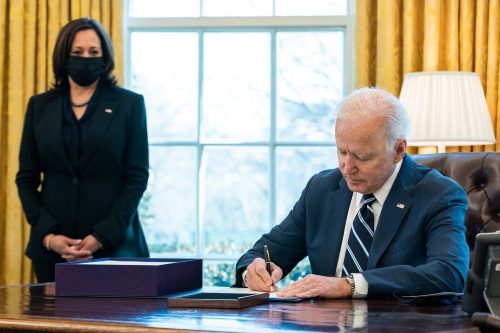Transportation Getting $100B From $1.9T COVID Package

The $1.9 trillion COVID-19 relief package, known as the American Rescue Plan or ARP recently reconciled between the House of Representatives and the Senate and signed into law by President Joe Biden on March 11, allocates $100 billion to transportation.
[Above photo of President Joe Biden signing the ARP into law. Photo via the White House.]
According to funding breakdown issued by Rep. Peter DeFazio, D-Ore., chair of the House Transportation & Infrastructure Committee, the final version of the COVID-19 relief legislation – known as the American Rescue Plan or ARP – includes:

- $50 billion for the Federal Emergency Management Agency to reimburse state, local, tribal, and territorial governments dealing with ongoing response and recovery activities from COVID-19. That money covers including vaccination efforts, deployment of the National Guard, providing personal protective equipment for public sector employees, and disinfecting activities in public facilities such as schools and courthouses. The legislation also directs FEMA to continue providing funeral assistance for COVID-19-related deaths.
- $30.5 billion for the transit sector to assist with operating costs, including payroll and personal protective equipment. That includes dedicated funding to support rural transit agencies, transit service for the elderly as well as individuals with disabilities, plus transit services on tribal lands.
- $8 billion to cover costs of airport operations, personnel, and cleaning, including a set-aside for rent relief and other costs of airport concessionaires primarily directed toward small businesses and minority-owned firms.
- $3 billion for the Economic Development Administration to provide economic adjustment assistance to help prevent, prepare for, and respond to economic injury caused by the COVID-19 pandemic. That includes a set-aside for communities that have suffered job losses in travel, tourism, or outdoor recreation activities.
- $3 billion to support a temporary payroll support program for the aerospace manufacturing industry to retain or rehire workers.
- $1.7 billion for Amtrak to recall and pay employees furloughed due to the COVID-19 pandemic through the end of fiscal year 2021 as well as restore daily long-distance passenger rail service. That includes a set-aside to help states cover lost revenue in state-supported Amtrak routes.
Rep. Sam Graves, R-Mo., the House T&I committee’s ranking member, noted in a March 2 hearing held prior to the ARP’s passage that the aviation sector took an immense economic hit from the COVID-19 pandemic.

“Year to year, looking at 2019 to 2020, passenger counts were down 60 percent,” he said in his remarks. “Congress has stepped up and twice provided the payroll support program because what is important is that we actually maintain the capacity of our airline industry and the ability to have business, recreational, and tourism travel available for when the economy picks back up again.”
Rep. Graves added that those investments are also helping maintain aviation industry “capacity,” especially where airports are concerned. “We’ve made investments in airports to ensure the infrastructure is there and ready to go,” he said. “This is absolutely integral to our economic recovery.”
A report compiled by the Airports Council International–North America trade association indicates U.S. airports will lose at least $17 billion between April 2021 and March 2022 due of the prolonged decline in commercial aviation traffic resulting from the COVID-19 pandemic.

Those losses are in addition to the $23 billion U.S. airports are expected to lose between March 2020 and March 2021.
Several state departments of transportation recently issued reports detailing the economic importance of airport investment.
The Alabama Department of Transportation’s Aeronautics Bureau issued a report on February 15 noting how the state’s 80 public airports are significant “economic engines,” generating more than $4.9 billion in state economic activity each year.
The North Carolina Department of Transportation’s Division of Aviation released a report entitled North Carolina: The State of Aviation showing how the state’s 72 publicly owned airports contribute $61 billion to North Carolina’s economy each year and support 373,000 jobs.
The Georgia Department of Transportation and the Alaska Department of Transportation & Public Facilities also issued similar reports.


